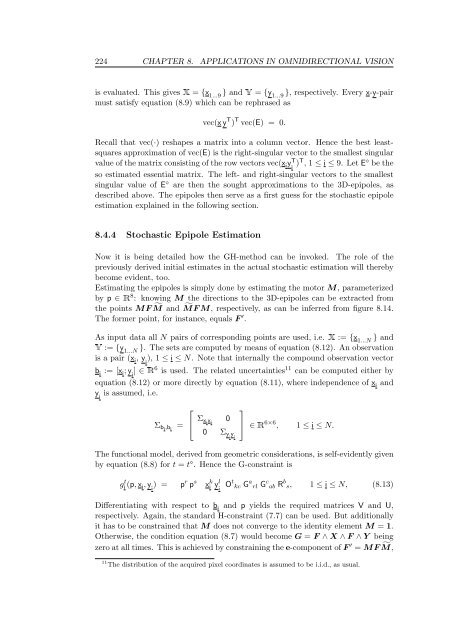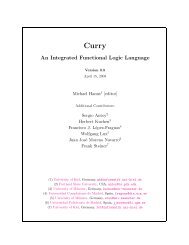Conformal Geometric Algebra in Stochastic Optimization Problems ...
Conformal Geometric Algebra in Stochastic Optimization Problems ...
Conformal Geometric Algebra in Stochastic Optimization Problems ...
Create successful ePaper yourself
Turn your PDF publications into a flip-book with our unique Google optimized e-Paper software.
224 CHAPTER 8. APPLICATIONS IN OMNIDIRECTIONAL VISION<br />
is evaluated. This gives � = {x 1...9 } and � = {y 1...9 }, respectively. Every x-y-pair<br />
must satisfy equation (8.9) which can be rephrased as<br />
vec(x y T ) T vec(E) = 0.<br />
Recall that vec(·) reshapes a matrix <strong>in</strong>to a column vector. Hence the best leastsquares<br />
approximation of vec(E) is the right-s<strong>in</strong>gular vector to the smallest s<strong>in</strong>gular<br />
value of the matrix consist<strong>in</strong>g of the row vectors vec(x iy T<br />
i )T , 1 ≤ i ≤ 9. Let E ⋄ be the<br />
so estimated essential matrix. The left- and right-s<strong>in</strong>gular vectors to the smallest<br />
s<strong>in</strong>gular value of E ⋄ are then the sought approximations to the 3D-epipoles, as<br />
described above. The epipoles then serve as a first guess for the stochastic epipole<br />
estimation expla<strong>in</strong>ed <strong>in</strong> the follow<strong>in</strong>g section.<br />
8.4.4 <strong>Stochastic</strong> Epipole Estimation<br />
Now it is be<strong>in</strong>g detailed how the GH-method can be <strong>in</strong>voked. The role of the<br />
previously derived <strong>in</strong>itial estimates <strong>in</strong> the actual stochastic estimation will thereby<br />
become evident, too.<br />
Estimat<strong>in</strong>g the epipoles is simply done by estimat<strong>in</strong>g the motor M, parameterized<br />
by p ∈ � 8 : know<strong>in</strong>g M the directions to the 3D-epipoles can be extracted from<br />
the po<strong>in</strong>ts MF � M and � MFM, respectively, as can be <strong>in</strong>ferred from figure 8.14.<br />
The former po<strong>in</strong>t, for <strong>in</strong>stance, equals F ′ .<br />
As <strong>in</strong>put data all N pairs of correspond<strong>in</strong>g po<strong>in</strong>ts are used, i.e. � := {x 1...N } and<br />
� := {y 1...N }. The sets are computed by means of equation (8.12). An observation<br />
is a pair (x i, y i ), 1 ≤ i ≤ N. Note that <strong>in</strong>ternally the compound observation vector<br />
b i := [x i;y i ] ∈ � 6 is used. The related uncerta<strong>in</strong>ties 11 can be computed either by<br />
equation (8.12) or more directly by equation (8.11), where <strong>in</strong>dependence of x i and<br />
y i is assumed, i.e.<br />
Σbi,bi =<br />
⎡<br />
0<br />
⎣ Σxixi 0 Σy y<br />
i i<br />
⎤<br />
⎦ ∈ � 6×6 , 1 ≤ i ≤ N.<br />
The functional model, derived from geometric considerations, is self-evidently given<br />
by equation (8.8) for t = t ⋄ . Hence the G-constra<strong>in</strong>t is<br />
g t i (p,x i, y i ) = p r p s<br />
x k i y l<br />
i Ot kc G a rl G c ab R b s, 1 ≤ i ≤ N, (8.13)<br />
Differentiat<strong>in</strong>g with respect to b i and p yields the required matrices V and U,<br />
respectively. Aga<strong>in</strong>, the standard H-constra<strong>in</strong>t (7.7) can be used. But additionally<br />
it has to be constra<strong>in</strong>ed that M does not converge to the identity element M = 1.<br />
Otherwise, the condition equation (8.7) would become G = F ∧ X ∧ F ∧ Y be<strong>in</strong>g<br />
zero at all times. This is achieved by constra<strong>in</strong><strong>in</strong>g the e-component of F ′ = MF � M,<br />
11 The distribution of the acquired pixel coord<strong>in</strong>ates is assumed to be i.i.d., as usual.
















